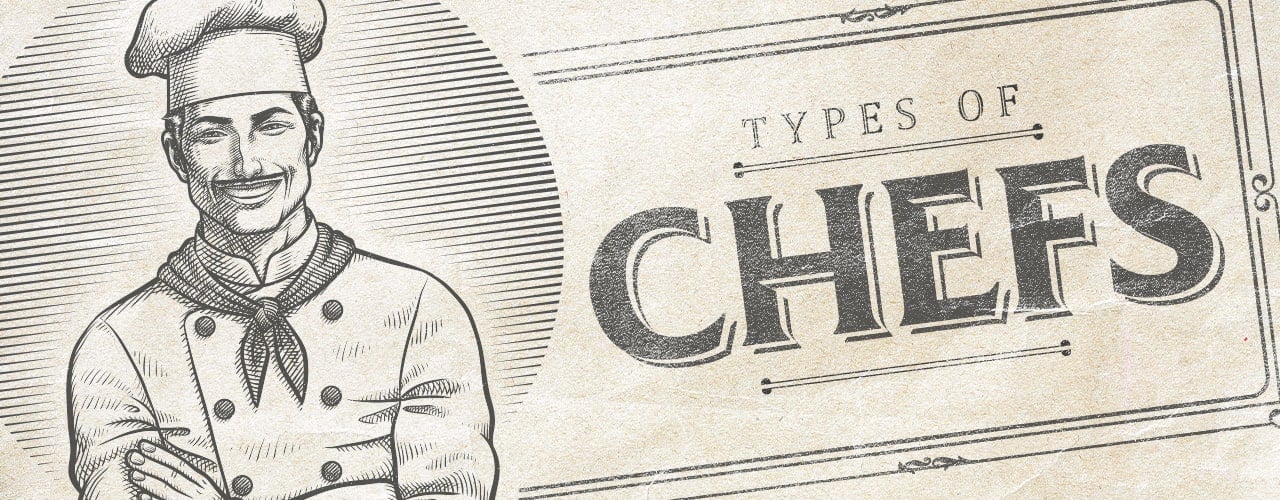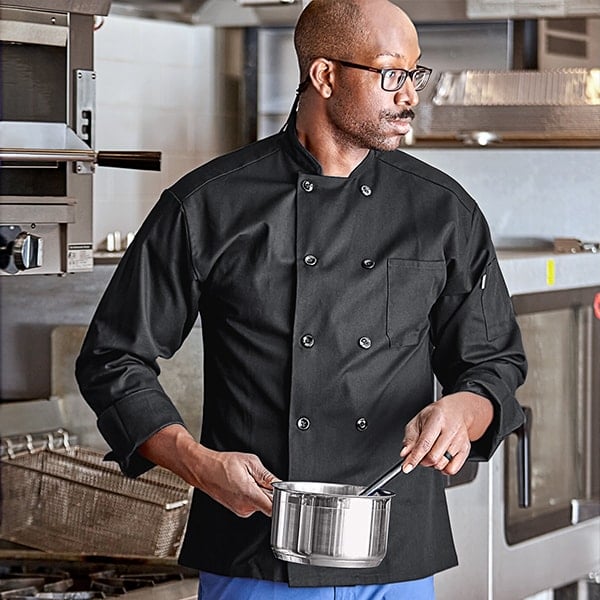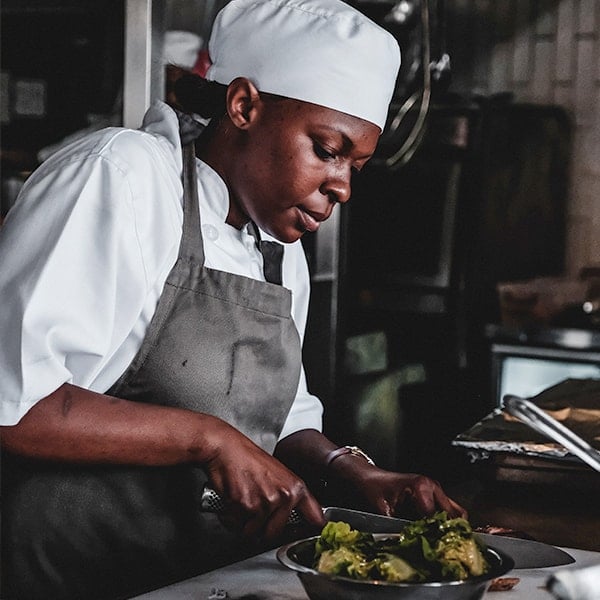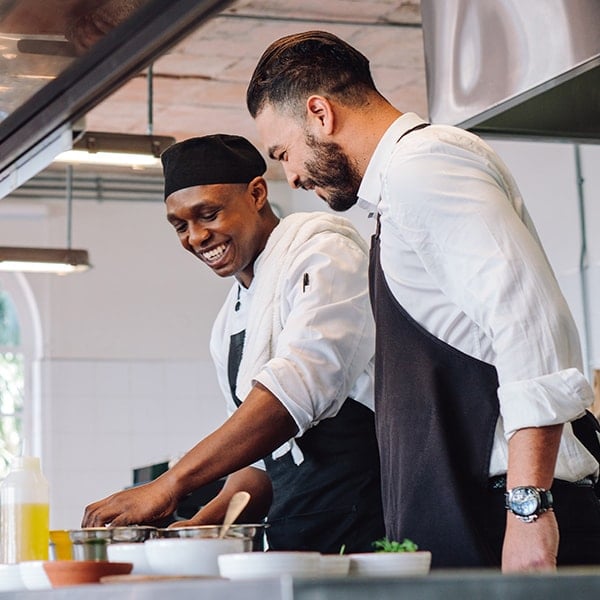
Different Types of Chefs
Last updated on 9/16/2022In a busy restaurant, one key factor for success is hiring the right chef. There can actually be various types of chefs operating in one kitchen. That leads us to ask, "What are the different types of chefs?" Read on to learn the difference between the various chef titles and the tasks those chefs perform in a bustling restaurant kitchen.
Chef Hierarchy
The different chef titles emerged in the 19th century with the creation of the French Brigade System. Chef Georges Auguste Escoffier created this system to provide restaurants with a kitchen hierarchy in order to operate more efficiently.
Not every kitchen operates under the French Brigade System. In modern days, many people think of this system as out of date since it portrays certain stations as more important than others when every station is equally important when it comes to running a successful restaurant . Besides that, it has provided a basic outline that restaurant owners can refer to when setting up their kitchen stations.
Different Types of Chefs
Chefs will generally hold higher-ranked positions in a kitchen. Additionally, a restaurant will usually have managerial chefs and specialized chefs. Each type of chef can cover a variety of different tasks, from organization and training to menu development and recipe creation. Becoming a chef requires years of education and experience, climbing from entry-level positions to the ultimate goal of executive chef.
Managerial Chefs
In managerial chef positions, there is an established hierarchy because these chefs have the most responsibility in the kitchen to ensure the restaurant's overall success. The following roles are listed in descending order.
Chef-Owner (Group Chef)

A chef-owner is a chef that starts their own restaurant.
- Primary Task: Business management
- Number Per Kitchen: One per kitchen
- Other Duties: Running the establishment and engineering a menu
Executive Chef (Chef de Cuisine, Head Chef)
An executive chef oversees all aspects of the kitchen.
- Primary Task: Kitchen management
- Number Per Kitchen: One per kitchen
- Other Duties: Oversee daily operations, kitchen costs, food preparation, menu planning , and create most of the recipes and dishes for the menu
Sous Chef (Second Chef, Under Chef)
A sous chef is the second in command and will run the kitchen in the executive chef’s absence.
- Primary Task: Team management
- Number Per Kitchen: Can be more than one in a kitchen depending on the size of the establishment
- Other Duties: Train newly hired chefs and cooks and oversee each dish's details
Senior Chef (Chef de Partie, Station Chef)
A senior chef is assigned one specialty on the menu that they excel in.
- Primary Task: Station management
- Number Per Kitchen: Can have more than one
- Other Duties: Specialists on a certain portion of the menu and will ensure that high-quality food leaves their station
Specialized Chefs
A hierarchy generally does not exist between specialized chefs. Each of them is an expert in their specific field.
Pastry Chef (Patissier)

The pastry chef is either the only person or the most senior person in the pastry department.
- Primary Task: Prepare pastries, breads, and desserts
- Number Per Kitchen: Can have just one for a small dessert menu, but there is normally an entire pastry team
- Other Duties: May be in charge of creating the whole dessert menu
Sauce Chef (Saucier, Saute Chef)
A sauce chef is the cook that prepares the sauces. This is mainly a position found in locations that serve French cuisine.
- Primary Task: Choose and prepare sauces and gravies for all meal types
- Number Per Kitchen: Normally one per kitchen
- Other Duties: May also prepare soups and stews
Fish Chef (Poissonier)
The fish chef is in charge of finding responsibly-raised seafood for the menu.
- Primary Task: Prepare and cook seafood
- Number Per Kitchen: Usually one per kitchen
- Other Duties: May also be responsible for sourcing and acquiring the seafood used in an establishment from a local market or non-local vendor
Vegetable Chef (Entremetier)

Handles all vegetables that are included in the various dishes on the menu.
- Primary Task: Prepare and cook vegetables and starches
- Number Per Kitchen: At least two per kitchen
- Other Duties: May also be responsible for some soup and egg dishes
Meat Chef (Rotisseur, Roast Chef)
Ensures all meats on the menu are properly sourced and cooked to meet the restaurant's standards.
- Primary Task: Prepare and cook meats by roasting, braising, broiling, or other methods
- Number Per Kitchen: Depending on menu size, normally just one is needed
- Other Duties: May also be in charge of obtaining the meat from local suppliers and retailers
Pantry Chef (Garde Manger)
The pantry chef, commonly known as garde manger or "garmo", creates decorative culinary centerpieces or buffet presentations.
- Primary Task: Preparing cold food items like salads, cold cuts, hors d’oeuvres, and dressings
- Number Per Kitchen: 1-2 depending on restaurant size
- Other Duties: Responsible for setting up buffet lines and adding centerpieces for an upscale presentation that may include carved and molded ice or fruits
Fry Chef (Friturier)
A fry chef handles any food that involves a fryolator, mainly needed in fast food establishments.
- Primary Task: Ensures foods are perfectly breaded and fried
- Number Per Kitchen: One if the menu is diverse, many more if the menu focuses on fried foods
- Other Duties: Clean out fryers and consult with butcher and vegetable chefs if need be
Grill Chef (Grillardin)
The grill chef will generally grill meats and sometimes vegetables.
- Primary Task: Grill meat, seafood, and vegetables
- Number Per Kitchen: Usually one grill cook
- Other Duties: Consult with butcher and vegetable chefs if need be
Butcher Chef (Boucher)
A butcher chef breaks down and prepares meat for other stations to use. They are mainly needed in larger establishments to keep up with the demand
- Primary Task: Prepare cuts of meat for other station chefs to cook
- Number Per Kitchen: One butcher is needed for restaurant kitchens
- Other Duties: Consult with fry and grill cooks, source and supply meats
Types of Cooks
Cooks will usually occupy entry-level positions in a kitchen and experience training from specialized chefs. They are more likely to cook by following recipes given to them and flow between the different cook positions as needed.
Line Cook (Commis)

A line cook is usually getting experience through the position. They will learn different cooking styles from the specialized chefs in the kitchen
- Primary Task: Cooking where needed and completing an assortment of kitchen tasks
- Number Per Kitchen: Rarely there will be just one in each kitchen, but it is size-dependent
- Other Duties: May be required to do miscellaneous tasks like plating dishes, taking orders, or cutting vegetables
Prep Cook (Kitchen Porter, Kitchen Hand, Kitchen Assistant)
A prep cook's responsibilities revolve around kitchen basics like chopping ingredients, finishing their prep lists , properly labeling containers in storage, and cleaning countertops.
- Primary Task: Daily food prep and kitchen tasks
- Number Per Kitchen: At least one per kitchen, but usually a whole team
- Other Duties: Perform other cooking duties as needed
Relief Cook (Chef de Tourant, Roundsman, Swing Cook)
A relief cook will assist chefs that may be overwhelmed at their stations.
- Primary Task: Fills in wherever needed
- Number Per Kitchen: Normally one relief cook
- Other Duties: Keeps work areas clean and tidy
Short Order Cook
A short order cook is responsible for quickly clearing as many order tickets as possible without sacrificing the quality of the meal
- Primary Task: Prepare quick and simple meals, mainly focusing on making foods like sandwiches and salads
- Number Per Kitchen: Usually 1-2 depending on menu and number of tables
- Other Duties: Manage food quality standards
Chef vs Cook
The difference between a chef and a cook is that a chef takes on more of a managerial role with their responsibilities. They will also usually have more specialized tasks, such as coming up with an entire menu or monitoring food costs and food orders. A cook is in charge of just that: cooking. Their main task is turning ingredients into beautifully plated works of edible art.
If you're interested in pursuing a career in the food service or hospitality industries, apply to WebstaurantStore's scholarship so we can help you meet your goals
Working in a commercial kitchen can be fast-paced in terms of daily tasks and upward mobility. Various chef and cook positions are needed to keep a restaurant running smoothly and the hierarchy can look very different from kitchen to kitchen. There are even more restaurant positions and jobs than listed above for the whole establishment to succeed. It is important to keep in mind that becoming a chef requires years of training. Work your way from the bottom up through the different jobs available, find an area you can specialize in, and pursue it with gusto.






